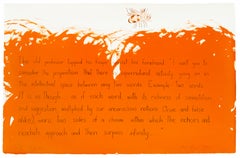Friedrich Specht Art
to
1
1
2
2
2
A Lying Animal - Original Lithograph by F. Specht - 1880
By Friedrich Specht 1
Located in Roma, IT
A Lying Animal is a black and white print realized by Friedrich Specht in 1880.
Lithograph on dark paper. Original Title: Derendet.
Dated 1880, p.24. Signed by the artist on the r...
Category
1870s Naturalistic Friedrich Specht Art
Materials
Lithograph
Cangaroos in Danger - Lithograph by F. Specht - 1879
By Friedrich Specht 1
Located in Roma, IT
Cangaroos in Danger is a black and white lithograph realized by Friedrich Specht in 1879.
Image dimensions: 19,7 x 13,7 cm.
Original Title: Am Auftralifchen "Bufch". Dated 1879 an...
Category
1870s Naturalistic Friedrich Specht Art
Materials
Lithograph
$231 Sale Price
30% Off
Related Items
Meditation and Minou
By Will Barnet
Located in Buffalo, NY
Artist: Will Barnet, American (1911 - 2012)
Title: Meditation and Minou
Year: 1980
Medium: Lithograph and Serigraph on BFK Rives, signed and numbered in pencil
Edition: 40/150
Category
1970s American Realist Friedrich Specht Art
Materials
Archival Paper, Lithograph
The Old Professor (Oo La La) Jim Dine lithograph and Ron Padgett poetry
By Jim Dine
Located in New York, NY
Bright orange leaps up like flames, or swaying grass, over which hovers a large-eyed bee sketched in black and orange. Over the fire-red in neat handwriting Ron Padgett...
Category
1970s Pop Art Friedrich Specht Art
Materials
Lithograph
$1,500
H 17 in W 27.5 in
Lithograph Titled: Two Hares in the Moonlight. New York Graphic Society, 1976.
Located in Chesterfield, MI
Lithograph By Cho Tai Eok
Published by New York Graphic Society, 1976.
Measures 39 x 15.5 in.
In Good Condition
Category
20th Century Friedrich Specht Art
Materials
Lithograph
$120 Sale Price
20% Off
H 39 in W 15.5 in
Roy De Forest, Dog lithograph, signed/n by world renowned California pet painter
By Roy De Forest
Located in New York, NY
Roy De Forest
Untitled (Dog), 1981
Color lithograph with deckled edges. Floated and framed.
Pencil signed and numbered from the edition of 125
Frame Included: held in original vintage white frame
Wonderful whimsical rare 1981 lithograph by the incredibly popular and beloved Roy de Forest, famous for his paintings and prints of dogs...
Category
1980s Surrealist Friedrich Specht Art
Materials
Lithograph
$1,700
H 35.25 in W 26.75 in D 1 in
Warner Brothers Orchestra Bugs Bunny Daffy Duck Porky Pig Cartoon Movie Legends
By Albert Al Hirschfeld
Located in New York, NY
Warner Brothers Orchestra Bugs Bunny Daffy Duck Porky Pig Cartoon Movie Legends
Al Hirschfeld (1903-2003)
Warner Brothers Orchestra
Etching and Aquatint
Sight 15 1/4 x 23 1/2 inches...
Category
1990s Performance Friedrich Specht Art
Materials
Paper, Lithograph
Erté, Ebony in White, 1982
By Erté
Located in Fairfield, CT
Artist: Erte, Romain de Tirtoff (1892-1990)
Title: Ebony in White
Year: 1982
Medium: Lithograph on wove paper
Size: 33 x 24 inches
Condition: Good
Inscription: Signed by the artist
N...
Category
1980s Art Deco Friedrich Specht Art
Materials
Lithograph
Lait pur de la Vingeanne (Pure Milk from Vingeanne), Lithographic poster.
By Théophile Alexandre Steinlen
Located in La Canada Flintridge, CA
It is framed with black moulding all around.
Era: Late 19th to early 20th century, often categorized under the Art Nouveau movement. The poster litho size is 36"x24", print informat...
Category
Early 1900s Art Nouveau Friedrich Specht Art
Materials
Lithograph
$950
H 37 in W 25 in D 0.75 in
“Europa and the Bull”
By Alvar Sunol Munoz-Ramos
Located in San Francisco, CA
You have to hand it to the bull. Not just taking Europa with his unassailable power (he is Zeus in disguise, after all) he brings along a retinue for his seduction of the beautiful P...
Category
1980s Modern Friedrich Specht Art
Materials
Paper, Lithograph
Femme a L'Eventail, Philippe Henri Noyer
By Philippe Henri Noyer
Located in Fairfield, CT
Artist: Philippe Noyer (1917-1985)
Title: Femme a L'Eventail
Year: circa 1969
Medium: Lithograph on Arches paper
Edition: 25/50 E.A., 375, plus proofs
Size: 29 x 41.75 inches
Conditi...
Category
1960s Impressionist Friedrich Specht Art
Materials
Lithograph
$1,276 Sale Price
20% Off
H 29 in W 41.75 in
Giorgio de Chirico 1960s Original Signed Lithography
By Giorgio De Chirico
Located in Roma, IT
Giorgio de Chirico 1960s Original Signed Lithography
Lithograph with golden yellow background
Signed in pencil lower left ‘P d A’ Artist's proof
Signed in pencil lower right ‘G. De ...
Category
1950s Modern Friedrich Specht Art
Materials
Paper, Lithograph
$2,124
H 27.56 in W 19.69 in D 0.79 in
Nixon + Spiro - Zero, Extremely rare 1968 political poster offset lithograph
Located in New York, NY
Unknown Artist
Nixon + Spiro - Zero, 1968
Extremely rare vintage 1960s Offset lithograph poster
28 × 22 inches
Publisher
Published by Joe A. Kennedy; printed by Provo Press
Unframed,...
Category
1960s Modern Friedrich Specht Art
Materials
Lithograph, Offset
$2,000
H 28 in W 22 in
Bear with Predella, Rubber Stamp Print on Arches Satine with Envelope Ed of 1000
By Don Nice
Located in New York, NY
Bear with Predella (from Rubber Stamp Portfolio), 1976
Rubber Stamp Print on Arches Satine with Envelope
8 × 8 inches
Edition of 1000
Unframed -...
Category
1970s Contemporary Friedrich Specht Art
Materials
Lithograph, Offset, Other Medium
Friedrich Specht art for sale on 1stDibs.
Find a wide variety of authentic Friedrich Specht art available for sale on 1stDibs. You can also browse by medium to find art by Friedrich Specht in lithograph and more. Not every interior allows for large Friedrich Specht art, so small editions measuring 8 inches across are available. Customers who are interested in this artist might also find the work of Samuel Howitt, Paul-Adolphe Rajon, and Isaac Slater. Friedrich Specht art prices can differ depending upon medium, time period and other attributes. On 1stDibs, the price for these items starts at $201 and tops out at $234, while the average work can sell for $217.
Artists Similar to Friedrich Specht
John Gould and Henry Constantine Richter

